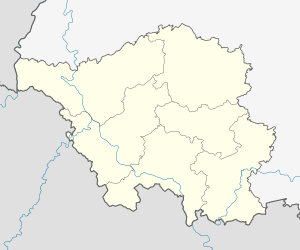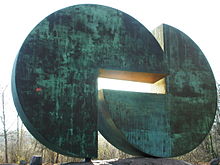Abt-Fulrad-Bridge (Kleinblittersdorf)
Coordinates: 49 ° 8 ′ 46 ″ N , 7 ° 2 ′ 32 ″ E
| L 253 Abt-Fulrad-Bridge N 61A | ||
|---|---|---|
| The bridge seen from the west bank | ||
| use | Road bridge | |
| Crossing of | Saar | |
| place | Auersmacher | |
| construction | Box girder bridge | |
| overall length | 171 m | |
| width | 11 m | |
| completion | 1983 | |
| location | ||
|
|
||
| Above sea level | 195 m above sea level NHN | |
The Abt-Fulrad-Brücke near Auersmacher is a cross-border road bridge with two lanes for vehicle traffic and footpaths on both sides between the EU member states of Germany and France .
Description and history
The Abt-Fulrad-Bridge was completed in 1983 after three years of construction. The costs amounted to about 4 million euros. The two-field structure with spans of 95 and 76 meters each spans the Saar as a border river and the Saarbrücken – Saargemünd railway line on the east bank . The substructure consists of reinforced concrete , the superstructure of steel. The access is on the west bank via two parallel ramps with a roundabout , on the opposite side for both directions via a loop ramp. The pedestrian path , which is still being developed and signposted on the German side, does not lead any further on the French side and only allows access to the national roads for motorized traffic.
The bridge was originally designed as a customs post with truck handling for cross-border passenger and freight traffic. It connects the B 51 running on the German side with the parallel route on the west bank of the national route 61 (feeder to the Paris – Strasbourg motorway near Hambach ) or the Départementale 31 bis (feeder to the Saarbrücken – Paris motorway near Forbach ). After the Schengen Agreement came into force only two years after its completion, the building and site of the border system on the east bank were already useless and have since been converted into an industrial area.
The name goes back to the Franconian nobleman Fulrad (710–784), abbot of the Saint-Denis monastery , one of the most influential personalities of the early Middle Ages. The nearby large community of Kleinblittersdorf owes its first documentary mention to the rich estates of his family in the Moselle and Maas area .
More than 4,000 vehicles use the bridge as a crossing every day. As early as 1998, the roadway had to be renewed due to the heavy traffic. The bridge was last repaired in 2011.
architectural art
On the site on the eastern shore is since 1987 one of tungsten Huschens created, gold glossy and partially covered with a greenish patina copper sheet - plastic (popularly Swiss cheese called). Two wheel-shaped bodies about one and a half meters high, each cut out in a quarter and interlaced at this point, symbolize the historical coexistence and opposition of the neighboring regions. The work is entitled "Border between Germany and France".
literature
- Heiko Lehmann: Road builders are giving Abt-Fulrad-Brücke an extensive renovation , in: Saarbrücker Zeitung of August 3, 2011 (last accessed on March 28, 2015)
- Franz-Ludwig Strauss: River crossings and mills in the area of the municipality of Kleinblittersdorf , part 3; in: Die Eul , Kleinblittersdorfer Hefte about past and present, 8th year, No. 12 (November); Pp. 11-12; Historic Association Saar-Blies eV (Ed.), Kleinblittersdorf 2014
Individual evidence
- ^ W. Huschens in the Kunstlexikon Saar (last accessed on December 1, 2013)



